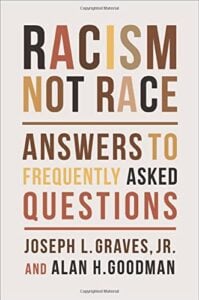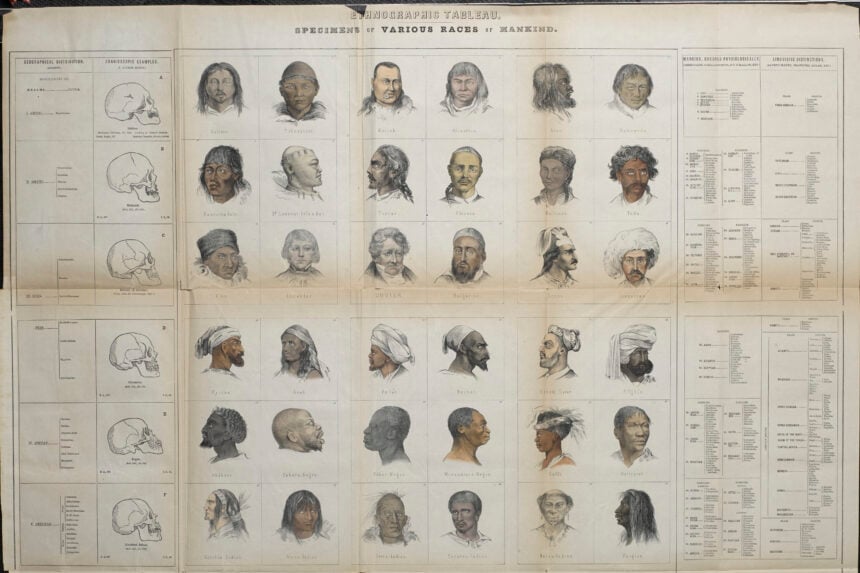
Racism, Not Race: Answers to Frequently Asked Questions
by Joseph L. Graves, Jr. and Alan H. Goodman
Columbia University Press
312 pp., $27.95
There is an old stereotype to the effect that scientists who may be capable, even brilliant, in their own field can be helpless, even illogical, in dealing with matters outside it. I have always doubted that this is common, although there are certainly some isolated cases. Racism, Not Race is a good example.
This is a remarkable book—in a bad way—a landmark in the decline of academic publishing; a work largely, if not entirely, composed of woke propaganda aimed at warding off a danger that doesn’t exist. The authors, Joseph Graves and Alan Goodman, a biologist and an anthropologist, respectively, complain about the logical fallacies often used in discussions of race—then exhibit those fallacies, and others, themselves.
The thesis—or dogma—of the book is that races are purely social constructs. “The science of human genetic variation shows with certainty that there are no biological races,” the authors announce. “Without this knowledge, it is difficult to confront biases that are based on biological and genetic myths about race.”
This is untrue. As David Reich, in his excellent 2018 book Who We Are and How We Got Here, and others have shown, genetic variations among human beings are greater than Graves and Goodman allow, and people do group roughly into biological races. (Reich prefers to use the term “ancestries” to avoid the real danger of confusing social and biological categories.) These groupings differ in some ways from the traditional classifications of anthropologists and those of early gene-mappers like Luigi Cavalli-Sforza. The new groupings are not “primordial” and are often relatively recent products of mixtures between groups that no longer exist in recognizable form. Human races now look not like the branches of a family tree but like a patchwork quilt.
The history of anthropology and the decline of “scientific,” or pseudo-scientific, racism is incompatible with the hysteria of Graves and Goodman over the supposed consequences of a belief in biological race. Most of the progress in reducing racial prejudice was made between the 1890s and the 1970s, a time span during which most scientists accepted that biological races existed but thought that the differences between them were not significant in terms of inborn intelligence or behavior. The belief in biological race, once held in common across society, is hardly the “rocket fuel of racism,” as Graves and Goodman claim. In any case, whether or not biological races exist is a question that should be answered on the basis of scientific evidence, not ideology or supposed social needs.
After summarily disposing of biological race, Graves and Goodman venture into lecturing about racism and related matters of history. They bombard readers with dogmas from current leftist ideology. They offer an extended “analysis” of the 57 varieties of racism, dismally familiar to students of critical race theory, including that most insidious version of all: color-blind racism. It is, of course, impossible for blacks to be racists, even if they happen to hate whites and Asians, because “racism is prejudice plus power,” and “reverse racism,” by definition, cannot exist. Affirmative action—which the authors can barely bring themselves to mention—is just an inadequate attempt to overcome “white privilege.”
When Graves and Goodman deal with historical fact, things get even worse. Repeatedly, they make absurd statements revealing their obsession with the idea that racism was devised as a modern Western excuse for colonization, plundering, and slavery. They claim that “no civilization or group from any part of the world had a concept of race at least until the late Middle Ages.” But the United States—all of it, apparently—was “founded on white supremacy and racial ideology” and remained so entrenched until the Civil Rights Act of 1964.
Native Americans, we are told, were not viewed as “God’s Children.” In fact, some suggested that they were not really human at all—but that idea was hastily squashed by the Catholic Church. The Spanish, and the French in Canada, were notably zealous in converting Amerinds, and the first American universities were founded as schools to train missionaries who could turn Amerinds into Protestants. Europeans were, for a considerable time, not particularly struck by the physical difference of Amerinds, whom they regarded as white.
Racism against blacks was, supposedly, devised to justify the transatlantic slave trade, which Graves and Goodman call “unique” in its singling out of one specific racial group for enslavement. Centuries prior, Europeans had picked up from Arabs the idea that blacks were inferior, and the transatlantic trade grew out of, and alongside, the old Mediterranean slave trade, which had dealt largely in Muslims; pagans from Central Asia, the Caucasus, and the Canary Islands; and, after the discovery of the Americas, Amerinds and even (until it was stopped by the Papacy) Orthodox Christian Europeans. Slavery did not become almost exclusively a subjugation of blacks until the 18th century; and even then, there were exceptions.
In a rare slap at non-Westerners, the authors tell us that the Japanese expansionists of the 1940s were motivated by racism, but, while obnoxious enough, the expansionists generally conceived of Japanese superiority and the right to rule in “spiritual” terms, not racial ones.
A particularly freaky—I can’t think of a better term for it—element of the book is the utterly inconsistent treatment of anti-Semitism. The authors switch back and forth between viewing anti-Semitism as a purely religious prejudice—anachronistically projecting the racial anti-Semitism of the late 19th and 20th centuries back onto earlier eras—and suggesting that the treatment of Jews in the late Middle Ages “presaged” racism.
We are blandly informed that pogroms against Jews occurred throughout European history, though in fact there were several centuries when Jews were left quite alone. The authors attach great significance to the “blue blood” obsession of the Spaniards and Portuguese, which created hostility toward descendants of Jews. But that phenomenon was not popular with other Europeans and had little to do with later racial thinking. The authors seem unaware that the “blue blood” nonsense was also aimed at people of Moorish ancestry and that there were probably more significant matters related to anti-Semitism, notably the social position of Jews as a classic “middleman minority”—a group playing the role of a middle class in a society otherwise composed of aristocrats and peasants, but different from either of those groups in religion and / or ethnicity, or in other ways.
Furthermore, Graves and Goodman are either oblivious to or just ignore the connections between racial anti-Semitism and the anti-Slav racism of the Nazis. The latter, which cost the lives of millions, is entirely ignored—a curious omission for people obsessed with the horrors of racism.
As we might expect, Racism, Not Race offers a prescription for what should be done about the titular problem. Somehow, it is not a surprise that Graves and Goodman’s solution turns out to be the same as the general leftist agenda for dealing with the world’s ills, which all seem tied, one way or another, to racism. Mass incarceration of criminals—not crime—is the great problem and should be dealt with by bail reform, legalizing drugs, and rendering the police toothless. Our miserable public schools should be cured by throwing more money at them, by equalizing funding between school districts, and by ending the evil of charter schools. That school failures might be due to stupid policies, lack of discipline, and the social problems of the underclass is not entertained.
Our political system, too, must be fixed. Among other things, voter identification and police patrols of voting locations should be eliminated. “All campaign ads on television and the internet must be rigorously fact-checked by independent entities before airing. Ads that do not pass fact checking cannot be aired,” Graves and Goodman write. One would like to know just who the “independent entities” exerting this censorship will be—but that’s the authors’ little secret.
Dispersed throughout the book are periodic tirades against Donald Trump, whom the authors denigrate as an obviously open racist, although they never cite any direct statement by Trump substantiating that label. One doesn’t have to be a Trump admirer to be skeptical of this practice.
The real target, however, turns out to be anyone who voted for Trump. Apparently gifted with either clairvoyance or telepathy, Graves and Goodman announce that “virtually every white person who voted for him” was, at least in part, unconsciously motivated by “white supremacist thinking.”
That shotgun blast is a curious parallel to the recent remarks made under red backlighting by Joe Biden in front of Philadelphia’s Independence Hall, in which he declared the Trumpian Republicans to be a major threat to our society. Perhaps Graves and Goodman have taken up speech-writing in addition to pseudo-scholarship.



Leave a Reply